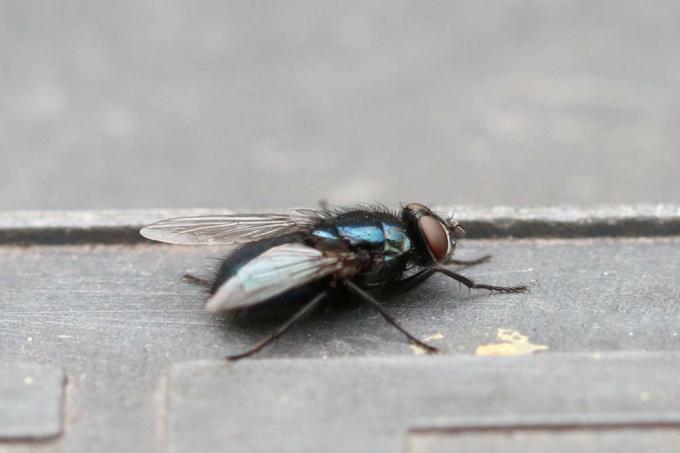
table of contents
- origin
- Life cycle
- Egg laying
- Fly larvae
- puppet
- Adult
- Feeding behavior of the larvae
Small, white, disgusting and usually in very large numbers, this is how maggots present themselves in the trash can. And the bizarre spectacle is often accompanied by an extremely unpleasant smell. No wonder that when you open the bucket you feel disgusted and your body hairs stand up, especially when yesterday everything in the garbage can apparently was still in order. And the question arises, where does the disgusting maggot carpet actually come from?
origin
The white maggots that you find in the garbage are usually the offspring of flies, especially the common housefly, also known as the fly for short. Because rubbish bins with leftovers are for Musca domestica, the scientific name of the common housefly, the ideal place to lay eggs.

Life cycle
The life of a housefly lasts between 6 and 42 days, depending on the temperature and food availability. The optimal ambient temperature for flies is between 20 ° C and 25 ° C, which is why we are plagued by the annoying insects, especially in summer.
Since the life of the fly does not last very long, the flies have to do so during the few weeks of their life ensure that the species is preserved, which is why they are explosive under ideal conditions multiply. For example, up to 15 generations of flies are possible in cattle sheds within a year. The life of a generation of houseflies is divided into four parts:
- egg
- three larval stages
- puppet
- Imago or Adult
Tip: The period from oviposition to the new fly takes only seven days under very good environmental conditions, but usually two to three weeks.
Egg laying
For successful reproduction, the female fly looks for the ideal place to lay eggs, so that the larvae that hatch from the eggs have enough food and optimal environmental conditions. Because the fly larvae feel particularly comfortable in a warm, humid climate and are protected from rotting substances feed, from the fly's point of view, a bucket of decomposing food is an ideal place for its Progeny.
Tip: Flies are literally attracted by the putrefaction gases produced by the organic waste in the bin. Therefore, you should always keep the bucket closed.
Fly larvae
Once the fly has found an ideal place to lay its eggs, the female housefly can lay between 150 and 400 eggs every three to four days. The fly larvae, also known as maggots, hatch from these eggs after 12 to 25 hours. The fly maggots themselves are up to twelve millimeters in size, white and have neither head nor legs. However, they can move through body curvatures. The food is taken in via forceps-like mouth hooks.

As a result of growth, the fly larvae molt twice. At the end of the third larval stage, i.e. after moulting twice, pupation is initiated.
Tip: The time between egg laying and hatching of the larvae is quite different for the different fly species. So hatch z. B. the blowfly maggots, especially with laying distress, already during or shortly after oviposition.
The maggot formation is also influenced by the climate in the waste bin. Since maggots love to be cuddly, they feel extremely comfortable in a warm and humid environment. Since the maggot formation is favored by high temperatures, they mainly occur in the summer months in the rubbish bin and in the organic waste bin.
puppet
As soon as the larvae pupate, the maggots can no longer move and they become immobile. Your skin hardens and so-called Barrel dolls. These are much smaller and darker than the fly larvae. The metamorphosis of the maggots within the pupae takes between three and eight days, depending on the temperature. When the transformation is complete, the finished fly leaves the doll.

Tip: The pupated maggots need a dry place for the metamorphosis from larva to fly. That is why you can often find the dolls on the underside of the lid of the garbage can.
Adult
Once the fly has left the pupa, it has reached the adult stage. Three days after hatching from the pupa, the new fly is sexually mature and mating can take place. Then the female flies are immediately ready to lay their eggs. And the next generation hatches in the form of larvae within a single day.
Tip: Since not all female flies lay their eggs at the same time, maggots in different larval stages can often be found in the garbage. Therefore, you should start combating maggots as soon as they appear.
Feeding behavior of the larvae
Maggots need a lot of protein for their development, which is why flies prefer to have their eggs in one Trash cans with protein-containing foods, such as meat, fish, cheese or bones, take off. Flies prefer to choose trash cans in which these protein sources are in the cooked state. The females are attracted by various smells that arise when protein is broken down. The fly larvae themselves are stuck upside down in the garbage after they have hatched from the eggs, where they literally live like “maggots in bacon”.

Tip: The female fly doesn’t care whether the protein-containing food is in the organic or residual waste bin. The only thing that counts for the female is that her offspring are well looked after.
If the organic waste consists exclusively of vegetable or plant residues, your trash can is not so attractive for flies, as this organic waste contains far less protein. However, even purely vegetable rubbish is not a guarantee for a maggot-free rubbish bin, as flies also lay their eggs in less attractive places when the eggs are in trouble.
